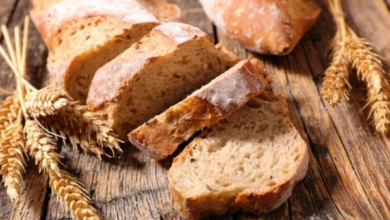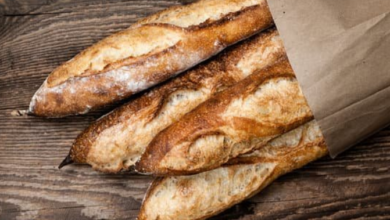Baguette Vs. White Bread: A Tale of Two Breads

What To Know
- The baguette’s crusty exterior yields to a soft, airy crumb, creating a delightful contrast that makes it a perfect accompaniment to cheese, charcuterie, and soups.
- White bread’s neutral flavor profile allows it to pair well with a wide range of toppings and fillings, making it a culinary chameleon.
- Bakers use a combination of hard and soft wheat flours to achieve the desired texture, while a higher proportion of yeast results in a faster rise, leading to a softer crumb.
The world of bread is a vast and diverse tapestry of flavors, textures, and histories. Among the many varieties that grace our tables, two stand out as iconic staples: the baguette and white bread. In this culinary showdown, we delve into the unique characteristics, origins, and culinary applications of these beloved loaves, unveiling their distinct contributions to the world of bread artistry.
A Tale of Two Crumbs: Baguette vs White Bread
1. Baguette: The Epitome of French Bread
The baguette, with its elongated shape and crispy crust, is a symbol of French culinary heritage. Its name, derived from the Italian word “bacchetta” meaning “stick,” aptly describes its slender form. The baguette’s crusty exterior yields to a soft, airy crumb, creating a delightful contrast that makes it a perfect accompaniment to cheese, charcuterie, and soups.
2. White Bread: The Versatile All-Rounder
White bread, often referred to as sandwich bread, is a ubiquitous presence in kitchens worldwide. Its soft texture and mild flavor make it a versatile choice for everything from sandwiches and toast to French toast and bread pudding. White bread’s neutral flavor profile allows it to pair well with a wide range of toppings and fillings, making it a culinary chameleon.
The Science Behind the Savor: Ingredients and Techniques
1. Baguette: A Symphony of Simplicity
The baguette’s composition is a testament to the power of simplicity. Made with just flour, water, yeast, and salt, the baguette relies on the expertise of the baker to achieve its signature crust and airy crumb. The high-hydration dough, with its increased water content, contributes to the crispy crust and open crumb structure.
2. White Bread: A Balancing Act of Flour and Yeast
White bread’s soft texture and mild flavor stem from its ingredients and production methods. Bakers use a combination of hard and soft wheat flours to achieve the desired texture, while a higher proportion of yeast results in a faster rise, leading to a softer crumb. The addition of sugar and shortening further enhances the bread’s softness and flavor.
From Oven to Table: Culinary Applications of Baguette and White Bread
1. Baguette: The Star of Sandwiches and Appetizers
The baguette’s crusty exterior and airy crumb make it an ideal bread for sandwiches. Its elongated shape allows for easy slicing, and its sturdy structure can withstand hearty fillings without becoming soggy. Baguettes also excel as appetizers, whether served with butter and jam, sliced and topped with cheese and charcuterie, or cut into croutons for salads.
2. White Bread: The Culinary Chameleon
White bread’s versatility shines through in its culinary applications. Its soft texture makes it perfect for sandwiches, toast, and French toast. Its mild flavor allows it to pair well with sweet and savory ingredients, making it a popular choice for grilled cheese sandwiches, BLTs, and peanut butter and jelly sandwiches. White bread also forms the base of many bread-based dishes, such as bread pudding, croutons, and bread crumbs.
The Verdict: A Matter of Taste and Occasion
In the battle of baguette vs white bread, there is no clear victor. Both loaves possess unique qualities that make them suitable for different culinary purposes. The baguette, with its crispy crust and airy crumb, is a delightful choice for sandwiches, appetizers, and as an accompaniment to soups and stews. White bread, with its soft texture and mild flavor, is a versatile all-rounder, perfect for sandwiches, toast, and a wide range of culinary creations.
A Culinary Journey Through Time: The History of Baguette and White Bread
1. Baguette: A French Culinary Icon
The baguette’s origins can be traced back to the 19th century in France. It is believed to have evolved from earlier forms of French bread, such as the pain long. The baguette quickly gained popularity due to its portability and ease of consumption, becoming a staple in French bakeries and homes. Today, the baguette is an integral part of French culture and cuisine, symbolizing the country’s rich breadmaking tradition.
2. White Bread: A Global Culinary Staple
The history of white bread is intertwined with the development of agriculture and the rise of wheat cultivation. Early civilizations in Mesopotamia and Egypt produced flatbreads using wheat flour. Over time, breadmaking techniques evolved, and white bread, with its soft texture and mild flavor, became a popular choice in many cultures worldwide. Today, white bread is a staple food in many countries, serving as a versatile base for sandwiches, toast, and other culinary creations.
Beyond the Loaf: Health Considerations
1. Baguette: A Crusty Choice with Nutritional Benefits
The baguette, with its high-hydration dough, is generally considered a healthier choice compared to white bread. The crusty exterior and airy crumb provide more fiber, which is beneficial for digestive health. Additionally, the lower glycemic index of the baguette means that it releases glucose more slowly into the bloodstream, helping to maintain stable blood sugar levels.
2. White Bread: A Culinary Delight with Nutritional Drawbacks
White bread, due to its refined flour and higher sugar content, is often criticized for its lower nutritional value compared to whole-grain breads. It has a higher glycemic index, which can lead to spikes in blood sugar levels. However, white bread can be enriched with vitamins and minerals to improve its nutritional profile.
Questions You May Have
1. What is the main difference between baguette and white bread?
The primary difference lies in their crust and crumb structure. Baguette possesses a crispy crust and an airy crumb, while white bread has a soft crust and a dense crumb.
2. Which bread is healthier, baguette or white bread?
Baguette is generally considered healthier due to its higher fiber content and lower glycemic index. However, the nutritional value of both breads can vary depending on the ingredients used and the manufacturing process.
3. Which bread is better for sandwiches, baguette or white bread?
Baguette is a suitable choice for sandwiches due to its sturdy structure and ability to withstand hearty fillings. White bread, with its soft texture, is also a popular choice for sandwiches, especially those with delicate fillings.





